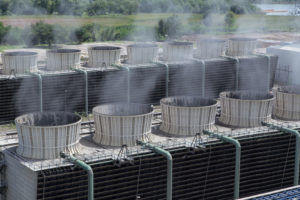Since 2018, when the first Legionella conference took place, operators of evaporative cooling systems, cooling towers and scrubbers must have their cooling water regularly checked for microbiological impurities such as legionella or bacteria.

This regulation was issued because there have been several cases in the USA where people have been infected with Legionella. The authorities have determined that these bacteria come from cooling towers. Legionella are aerobic bacteria and can be transmitted by drops of water.
In certain weather conditions the evaporation fumes do not rise to the top. Especially in valley basins, these vapours from the cooling tower remain close to the ground. This is how people have become infected with Legionella. In order to avoid such infections in the future, this regulation has been adopted.
Threshold values
The regulation can be found in several places on the Internet, like the CDC in the US or similar organisations in other countries.
Here is a summary from our point of view.
In Europe the regulation defines the condition of the installations,how such installations should be operated and above all how and what needs to be checked. Own checks should be made every 14 days. Every 3 months a certified test laboratory must carry out these tests. Only when the measured number of legionella have stabilized at a low level over a longer period of time, it needs to be checked less frequently.
In an evaporation cooling plant the limit values are 100, 1,000 and 10,000 CFU/100ml. If the limit values of the respective stage, i.e. the bacterial counts are exceeded, graduated measures must be taken. If the highest stage 3 exceeds >10,000 CFU, shock flushing with biocide must be carried out. This sometimes floods the entire cooling circuit. This can be quite expensive, especially in large cooling systems.
The problem of reaching all Legionella
Whether in a drinking water system of a hospital or in the cooling circuit of an industrial plant, the main problem of any measure is always to „catch“ all legionella.
Biofilms are the breeding grounds of legionella. So if it is not possible to remove all biofilm during the shock rinse, the bacteria will grow again in a short time and the cycle will start again. As already described elsewhere, biocides can only affect bacteria with which they come into contact. The same applies to heat sanitation or UV systems.
If a bacterium sits well protected in a layer of biofilm in a pipe that is not flown through, neither heat nor chemicals will reach the bacterium. Not to mention UV light.
Merus also works in dead pipes
The Merus technology also reaches dead legs in pipes or machines. We are therefore able to remove biofilm from those parts of the pipe with no flow. Even without open them. The reason for this is that the Merus oscillations move much faster in water than the water itself. This way the oscillations also reach parts of the pipe that are not flowed through and so minimize the biofilm. Once the biofilm has disappeared, the bacteria no longer have a breeding ground and colonies become extinct.
Merus is thus able to significantly reduce the number of legionella in cooling water and usually bring it below the required threshold values.
If the number of bacteria is constantly below the limit of the lowest level, i.e. less than 100 CFU/100ml, the frequency of tests can also be reduced.
Many customers then stop the use of biocides or thermal measures for their cooling water. In this way, operators of cooling systems can achieve considerable savings.
